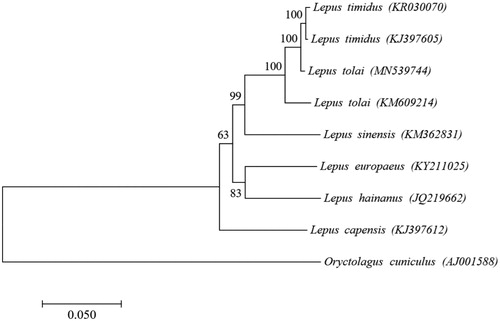Abstract
Lepus tolai has a wide geographic distribution in the world, and there are some taxonomic confusions due to lack of studies. The complete mitochondrial genome of L. tolai in Xinjiang is 17,047 bp long with 13 protein-coding genes (PCGs), 22 tRNAs, two rRNAs, and a control region. The overall base composition is 31.81% of A, 29.40% of T, 25.67%of C, and 13.12% of G, showing AT-rich. Phylogenetic analysis results showed that L. tolai is closely related to Lepus timidus, and distantly related to Lepus earoupenses and Lepus capensis. The new mtDNA data will supplement the mitochondrial gene pool of Lepus and helpful for validating taxonomic status of L. tolai on mtDNA level.
Tolai hare (Lepus tolai Pallas, 1778) has a wide geographic distribution in the world from low to high altitude. In China, its geographic distribution includes northeastern, northwestern and middle China (Smith and Xie Citation2009). There are some taxonomic confusions on L. tolai due to lack of studies and remote landscape. For example, it has been assigned in the Lepus capensis and Lepus europaeus. Problems in subspecies among these various taxa are more prominent. But, parsimoniously, according to Andrew, L. tolai in China are divided into seven subspecies, in which two subspecies L. t. centrasiaticus and L. t. lehmanni are distributed in Xinjiang (Smith et al. Citation2018). Ding et al. (Citation2014) reported a complete mtDNA sequence of this species, but no information about the collection site, and phylogenetic relationship in their article. In this study, we characterized the mtDNA genome of Tolai hare in Xinjiang to provide data on mitochondrial genes of L. tolai and constructed phylogenetic tree to further validate taxonomic status on mtDNA level.
An adult Tolai hare, collected from Altay Xinjiang, China (88°08′N, 47°50′E) in December 2017, was used for analysis in this study, and the specimens (ALT-17) were stored at the animal museum in Xinjiang Key Laboratory of Biological Resources and Genetic Engineering in Xinjiang University. The complete mtDNA was sequenced via next-generation sequencing using an Illumina Hiseq platform in Hengchuang Gene Technology Shenzhen, China and assembled using SPAdes (3.9.0). Genome components were analyzed via DOGMA2 and MITOS (http://dogma.ccbb.utexas.edu/; Matthias et al. Citation2013). Base composition and composition skew analysis were performed using MEGA7 and the formulas, AT skew = [A − T]/[A + T] and GC skew = [G − C]/[G + C] (Perna and Kocher Citation1995). Phylogenetic analysis was performed using maximum-likelihood method in MEGA 7.0 (Kumar et al. Citation2016).
The length of the complete mitogenome of L. tolai is 17,047 bp (GenBank accession: MN539744) with 13 protein-coding genes (PCGs), 22 tRNAs, two rRNAs, and a control region, similar to other vertebrates (Huang et al. Citation2019; Prabhu et al. Citation2019). The overall base composition of mtDNA is 31.81% for A, 29.40% for T, 25.67% for C, and 13.12% for G. The AT skew is 0.039 and GC skew is −0.324 indicating C richness over G. These skewness is different in some species such as insects, fish, and mammals (Perna and Kocher Citation1995; Mao et al. Citation2019). Except for nad6 and eight tRNAs, other genes are encoded on the heavy (H) strand. Phylogenetic tree () based on complete mitogenome sequence showed that L. tolai in Xinjiang (MN539744) has close relationship with another Tolai hare in China (KM609214) and L. timidus, while distantly related to L. europaeus and L. capensis, which suggesting that it should not be included in L. capensis and L. europaeus (Smith et al. Citation2018). The results of complete mitochondrial sequence analysis and phylogeny of L. tolai in Xinjiang will supplement the mitochondrial gene pool of Lepus and will be helpful for solving the taxonomic confusion of L. tolai.
Disclosure statement
The authors report no conflicts of interest. The sequence has been submitted to NCBI under the accession no. MN539744.
Additional information
Funding
References
- Ding L, Chen CM, Wang H, Zhang BW. 2014. Complete mitochondrial DNA sequence of Lepus tolai (Leporidae: Lepus). Mitochondrial DNA A. 27(3):2085–2086.
- Huang YL, Chen YX, Guo HT, Xu YH, Liu HY, Liu DW. 2019. The complete mitochondrial genome sequence of Yarkand hare (Lepus yarkandensis). Mitochondrial DNA B. 4(2):3727–3728.
- Kumar S, Stecher G, Tamura K. 2016. MEGA7: molecular evolutionary genetics analysis version 7.0 for bigger datasets. Mol Biol Evol. 33(7):1870–1874.
- Mao QM, Li TJ, Fu WB, Yan ZT, Chen W. 2019. Sequencing of the complete mitochondrial genome of Anopheles lindesayi and a phylogenetic analysis of the genus Anopheles (Diptera: Culicidae) based on mitochondrial genomes. J Insect. 62(1):101–116.
- Matthias B, Alexander D, Frank J, Fabian E, Catherine F, Guido F, Joern P, Martin M, Peter FS. 2013. MITOS: improved de novo metazoan mitochondrial genome annotation. Mol Phylogenet Evol. 69:313–319.
- Prabhu VR, Arjun MS, Bhavana K, Prabhu VR, Arjun MS, Bhavana K, Kamalakkannan R, Nagarajan M. 2019. Complete mitochondrial genome of Indian mithun, Bos frontalis and its phylogenetic implications. Mol Biol Rep. 46(2):2561–2566.
- Perna NT, Kocher TD. 1995. Patterns of nucleotide composition at fourfold degenerate sites of animal mitochondrial genomes. J Mol Evol. 41(3):353–358.
- Smith AT, Johnston CH, Alves PC, Hacklander K. 2018. Lagomorphs: Pikas, rabbits, and hares of the world. Baltimore: Johns Hopkins University Press.
- Smith AT, Xie Y. 2009. A guide to the mammals of China. Changsha: Hunan Education Publishing House.

